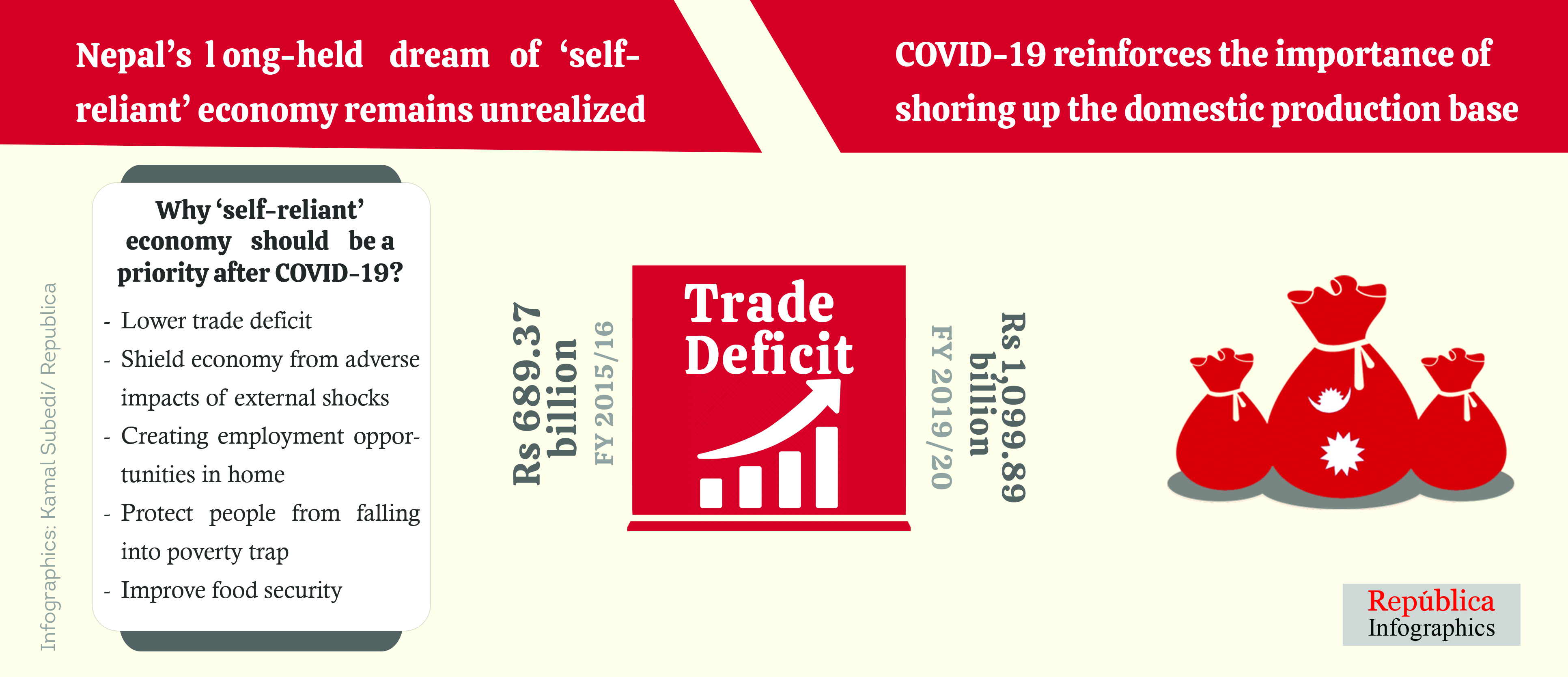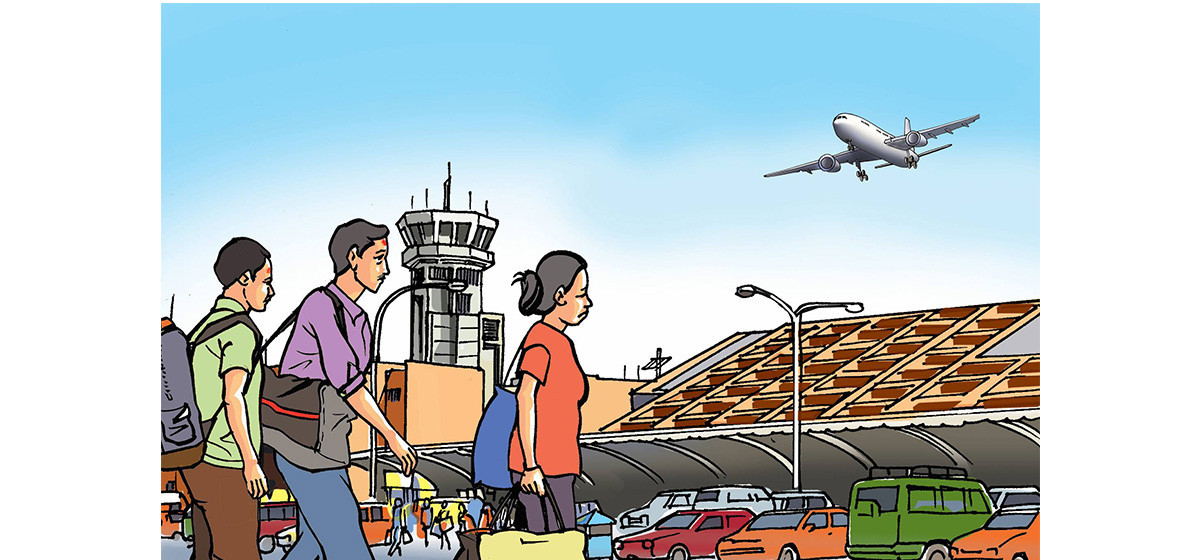
OR
How COVID-19 provides an opportunity to chart a self-reliant economy
Published On: October 17, 2020 08:56 PM NPT By: Sagar Ghimire | @sagarghi

Like during previous shocks, the pandemic once again renews the call to build a ‘self-reliant’ economy. But will the government listen and act, or miss the opportunity once again like it did in the aftermath of the earthquakes and the unofficial Indian embargo in 2015?
KATHMANDU, Oct 17: The unofficial Indian trade embargo imposed in 2015 after the promulgation of the new constitution laid bare the risk of Nepal’s ‘heavy dependence’ on its southern neighbor.
The trade embargo resulted in acute shortages of essential supplies like medicines and cooking gas. The blockade was especially severe in the immediate aftermath of the devastating earthquakes of 2015. The blockade was interpreted as a clarion call for the government to orient the economy toward self-reliance.
Political leaders, authorities and policymakers as well as other stakeholders reiterated their commitments to work toward building an self-reliant economic framework.
Five years down the line, the dream of a ‘self-reliant’ economy has largely remained unrealized. Our dependence continues to rise at an ‘alarming’ rate as indicated by trade data. The vulnerability of Nepal's economy as a result of increasing dependence on others has been further exposed by the pandemic that has halted economic activities here at home.
According to Nepal Rastra Bank, Nepal’s trade deficit ballooned to 1,099.89 billion rupees in FY 2019/20 from 689.37 billion rupees five years ago in FY 2015/16.
As the government measures have left either no or little effect on abating the growing dependence, the pandemic has once again reinforced the importance of a self-reliant economy, albeit in a different way.
Experts and economists say that promoting the local production in the country not only lowers the trade deficit and reliance on other countries but also helps in shielding the economy from the adverse impacts of shocks like COVID-19.
If there was a robust production base, it could have generated employment opportunities to absorb workers who returned from abroad after losing their jobs.
“COVID-19 has posed a challenge for us to create employment opportunities for millions. Thousands of Nepali workers have either returned or are likely to return from abroad after losing jobs,” said Nara Bahadur Thapa, an economic expert. “This challenge has shown us once again why we should promote our domestic production. If we had a self-reliant economy, we should not have worried much about providing them employment opportunities,” he said.
Agriculture: mainstay of self-reliant economy
While any economy cannot remain completely detached, there should be certain strategic sectors, services or products where it should be self-reliant, say economists.
Experts see agriculture as one key sector which could become self-reliant in the near to medium term. Agro products like food, vegetables and fruits account for nearly one-fifth of the total imports.
They say that priority should be given to reducing reliance on agricultural products to significantly cut the import bill, but also to enhance the economy's resilience to shocks and stresses like COVID-19.
While 65 percent of the population is dependent on agriculture, the country continues to rely on imports even for foodgrains, vegetables and fruits. Experts say that transformation of agriculture from subsistence to commercialization should be the strategy to boost our production. “If the government puts in place the right strategies, approaches and interventions, our goal of self-reliance in agricultural products is not difficult to achieve,” said Thapa.
Protecting people from falling into poverty trap
The pandemic is also likely to push millions into poverty. The government should make investments in agriculture that ensures sustainable livelihoods for millions as well as promote small and micro enterprises that could become a source of both self-employment and jobs, according to economists.
Nepal has made successful strides in reducing poverty from 25.2 percent in 2011 to 21.6 percent in 2015. However, the pandemic threatens to plunge hundreds of thousands of people into poverty and reverse all the gains made in the last few years.
Experts say that the government should encourage commercialization of agriculture so that it becomes a sustainable source of income for the majority of the population.
By promoting and linking micro and medium enterprises to the agriculture sector, the government can help in boosting local agro production while also providing employment opportunities to those who have lost their income or livelihoods.
“Besides helping farmers in increasing productivity, policies and activities offered by the governments need to be focused on creating effective market linkages from farm to fork. More needs to be done to create an ecosystem where micro and small agri-businesses can be involved in processing, packaging and bringing products to the market,” said Dikshya Singh, an economist at South Asia Watch on Trade, Economics and Environment (SAWTEE ).
“If it becomes cheaper to import vegetables rather than buy it from farmers in relatively remote areas of the country, we cannot uplift the agriculture sector,” she said, urging the government to increase investment in supporting the value chain and market infrastructure. “Moreover, governments - all three tiers - can strengthen and better plan their existing agriculture-related activities, starting with improving farmers’ access to improved seeds, fertilizers and other agriculture-extension services, this could not only help meet the goal of ‘self-reliance’ but also have a positive impact on the livelihoods of farmers,” she added.
Improving food security
The pandemic is also a wake up call to think about food security. Any external shock that impacts imports makes the country vulnerable to food shortages.
“We cannot rule out the possibility of unavailability of food because of drought, flood, crop failure or other disasters. Relying too much on imports makes us vulnerable to such shocks. Boosting the local production and becoming self-reliant in foods is also important to ensure the right to food to every citizen,” said Thapa.
Ensuring nutrition and food security has been one of the biggest challenges faced by most of the South Asia countries, including Nepal. Lack of adequate food and nutrition has resulted in various kinds of diseases.
Roadmap to recovery
As the government has been introducing measures to revive the economy battered by the pandemic, its policy support should be geared toward self-reliance that promotes local production.
Such policy support will not only make the economic growth sustainable, but also resilient. The agriculture sector acts as a strong lever for economic growth, and the government should increase its investments to help commercialize and modernize farming.
Micro and small enterprises can play a very strong role in creating a strong agriculture ecosystem. The enterprises that are struggling for survival should be at the center of the government’s stimulus or economic revival packages. If supported through cheaper and subsidized loans and tax incentives, they can increase production and help the country to achieve its goal of a self-reliant economy.
You May Like This

Lack of investment-friendly laws raises concerns as Investment Summit approaches
KATHMANDU, April 20: Despite the private sector’s recommendations to amend about two dozen laws to promote both foreign and domestic... Read More...
_20220508065243.jpg)
Over 400,000 tourists visited Mustang by road last year
MYAGDI, April 19: Over 400,000 tourists visited Mustang in a one-year period from April 14, 2023 to April 12, 2024... Read More...

19 hydropower projects to be showcased at investment summit
KATHMANDU, April 19: The upcoming third Nepal Investment Summit scheduled for April 28 and 29 will feature 19 hydropower projects... Read More...





Just In
- 120 snow leopards found in Dolpa, survey result reveals
- India funds a school building construction in Darchula
- Exploring opportunities and Challenges of Increasing Online Transactions in Nepal
- Lack of investment-friendly laws raises concerns as Investment Summit approaches
- 550,000 people acquire work permits till April of current fiscal year
- Fixing a win by outlawing dissent damages democracy
- MoHP cautions docs working in govt hospitals not to work in private ones
- Over 400,000 tourists visited Mustang by road last year










_20220508065243.jpg)

Leave A Comment